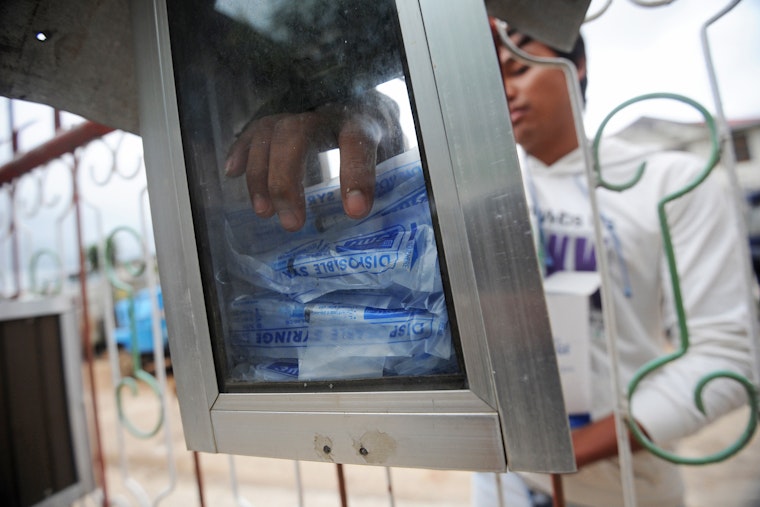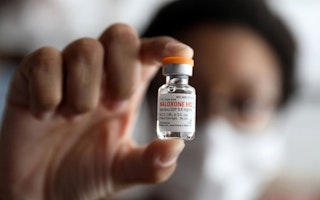In the Fight against AIDS, People Who Inject Drugs Are Being Left Behind
By Tom Henderson

Today, on World AIDS Day, you will repeatedly hear the mantra “leave no one behind,” referring to the concerted effort to end AIDS by 2030 pledged in the UN’s Sustainable Development Goals. But evidence shows that people who use drugs, a population at particular risk of HIV transmission, are in fact being left further and further behind.
The best way to limit the transmission of HIV—along with hepatitis C—among this population is through harm reduction. This refers to specific health interventions, such as drug consumption rooms, needle and syringe programs, opioid substitution therapy, and overdose reversal treatment.
But it also refers to the wider pragmatic, evidence-based approach to drugs on which these interventions are founded. This philosophy accepts that drugs, licit or illicit, have been and will always be used, while recognizing the specific risks and harms related to drug use in different contexts, which can and should be minimized.
For the last 10 years, Harm Reduction International has monitored global levels of harm reduction provision for our biennial Global State of Harm Reduction report. In this time, we’ve seen a slow but steady increase in the number of countries providing harm reduction.
But for the first time, this year’s report shows no increase at all in the number of countries with at least one needle and syringe program. Alarmingly, this comes alongside an increase in rates of stimulant injecting in every part of the world. Of 158 countries with reported injecting drug use, more than a third have no needle and syringe programs at all, and over half do not offer opioid substitution therapy.
It is therefore unsurprising that the UN’s 2011 target to halve HIV transmission among people who inject drugs by 2015 was missed by more than 80 percent. If we are to come even close to ending AIDS by 2030, we cannot afford this slowdown.
Harm reduction not only saves lives, it saves money. Both needle and syringe programs and opioid substitution therapy offer a three- to fourfold return on investment. Meanwhile, providing overdose reversal kits and training is among the most cost-effective of all lifesaving interventions.
Yet UNAIDS reports that between 2010 and 2014, only 3.3 percent of HIV prevention spending was directed towards people who inject drugs, with just a third of this coming from national governments. More worryingly, international donors that have funded harm reduction to date are now retreating from middle-income countries, where most people who inject drugs live, and overall donor funding for HIV is in decline.
By contrast, an estimated $100 billion is spent each year on ineffective and often harmful drug control and enforcement measures. Statistical modeling commissioned by Harm Reduction International earlier this year shows that with just $7.5 billion, we could virtually end HIV transmission and HIV-related deaths among people who inject drugs by 2030. Instead, unthinkable sums are poured into strategies such as mass incarceration, with one in every five prisoners around the world detained on drug-related charges, most for personal use and possession.
Harm reduction in prisons (and in the broader community) is not just a health concern, it is a binding human rights obligation. Denying prisoners methadone—the most common opioid substitute, and one of the World Health Organization’s “essential medicines”—is a violation of their right to health, and potentially of freedom from inhuman and degrading treatment because of the pain, suffering, and humiliation that withdrawal generates. Preventing prisoners from protecting themselves against HIV and viral hepatitis by denying harm reduction is another violation of the right to health. Furthermore, when these services are available to the general public, but not to prisoners, this violates the right to nondiscrimination.
The outcome documents from two major UN processes in 2016—the UN General Assembly Special Session on drugs (UNGASS) and the High-Level Meeting on Ending AIDS—did urge countries to scale up harm reduction, including in prisons. But our latest data shows that this language does not reflect funding or political commitments on the ground, or within UN agencies.
Since UNGASS, UNAIDS has cut 75 percent of its funding for the HIV team at the UN Office on Drugs and Crime (UNODC), which leads the UN’s work with people who inject drugs, meaning it will have to halve its work on HIV in prisons, and close projects on alternatives to imprisonment and on women who use drugs. Next year, UNODC will lose all but one of its regional HIV advisors, while UNAIDS itself no longer has any post dedicated to HIV and drug use.
We have the tools, the know-how, and the political commitments to end the HIV epidemic by 2030, but we do not yet have the political will or the money to do it. Much more work is needed at local, national, and regional levels to keep scaling up harm reduction services and ensure that, come 2030, truly no one has been left behind.
Harm Reduction International is a grantee of the Open Society Foundations.
Tom Henderson is the communications officer at Harm Reduction International.

